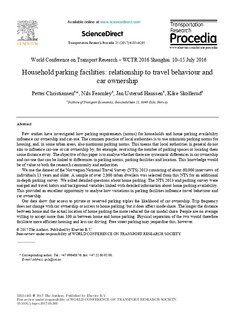| dc.contributor.author | Christiansen, Petter | |
| dc.contributor.author | Fearnley, Nils | |
| dc.contributor.author | Hanssen, Jan Usterud | |
| dc.contributor.author | Skollerud, Kåre H. | |
| dc.coverage.spatial | Norway | nb_NO |
| dc.date.accessioned | 2019-06-27T06:48:11Z | |
| dc.date.available | 2019-06-27T06:48:11Z | |
| dc.date.created | 2017-06-22T11:04:26Z | |
| dc.date.issued | 2017-06-08 | |
| dc.identifier.citation | Transportation Research Procedia. 2017, 25 4185-4195. | nb_NO |
| dc.identifier.issn | 2352-1465 | |
| dc.identifier.uri | http://hdl.handle.net/11250/2602423 | |
| dc.description.abstract | Few studies have investigated how parking requirements (norms) for households and home parking availability influence car ownership and car-use. The common practice of local authorities is to use minimum parking norms for housing, and, in some urban areas, also maximum parking norms. This means that local authorities in general do not aim to influence car-use or car ownership by, for example, restricting the number of parking spaces or locating them some distance away. The objective of this paper is to analyse whether there are systematic differences in car ownership and car-use that can be linked to differences in parking norms, parking facilities and location. This knowledge would be of value to both the research community and authorities.
We use the dataset of the Norwegian National Travel Survey (NTS) 2013 consisting of about 60,000 interviews of individuals 13 years and older. A sample of over 2,000 urban dwellers was selected from this NTS for an additional in-depth parking survey. We asked detailed questions about home parking. The NTS 2013 and parking survey were merged and travel habits and background variables linked with detailed information about home parking availability. This provided an excellent opportunity to analyse how variations in parking facilities influence travel behaviour and car ownership.
Our data show that access to private or reserved parking triples the likelihood of car ownership. Trip frequency does not change with car ownership or access to home parking, but it does affect mode share. The longer the distance between home and the actual location of home parking the more reduced the car modal share. People are on average willing to accept more than 100 m between home and home parking. Physical separation of the two would therefore facilitate more efficient housing and less car driving. Free street parking may jeopardise this, however. | nb_NO |
| dc.language.iso | eng | nb_NO |
| dc.publisher | Elsevier | nb_NO |
| dc.rights | Attribution-NonCommercial-NoDerivatives 4.0 Internasjonal | * |
| dc.rights.uri | http://creativecommons.org/licenses/by-nc-nd/4.0/deed.no | * |
| dc.title | Household parking facilities: relationship to travel behaviour and car ownership | nb_NO |
| dc.title.alternative | Household parking facilities: relationship to travel behaviour and car ownership | nb_NO |
| dc.type | Journal article | nb_NO |
| dc.type | Peer reviewed | nb_NO |
| dc.rights.holder | © 2017 The Authors. Published by Elsevier B.V. | nb_NO |
| dc.description.version | publishedVersion | nb_NO |
| cristin.unitcode | 7482,1,1,0 | |
| cristin.unitcode | 7482,1,5,0 | |
| cristin.unitcode | 7482,1,2,0 | |
| cristin.unitname | Reisevaner og mobilitet | |
| cristin.unitname | Marked og styring | |
| cristin.unitname | Byutvikling og bytransport | |
| cristin.ispublished | true | |
| cristin.fulltext | original | |
| cristin.qualitycode | 1 | |
| dc.identifier.doi | 10.1016/j.trpro.2017.05.366 | |
| dc.identifier.cristin | 1478143 | |
| dc.source.journal | Transportation Research Procedia | nb_NO |
| dc.source.volume | 25 | nb_NO |
| dc.source.pagenumber | 4185-4195 | nb_NO |

